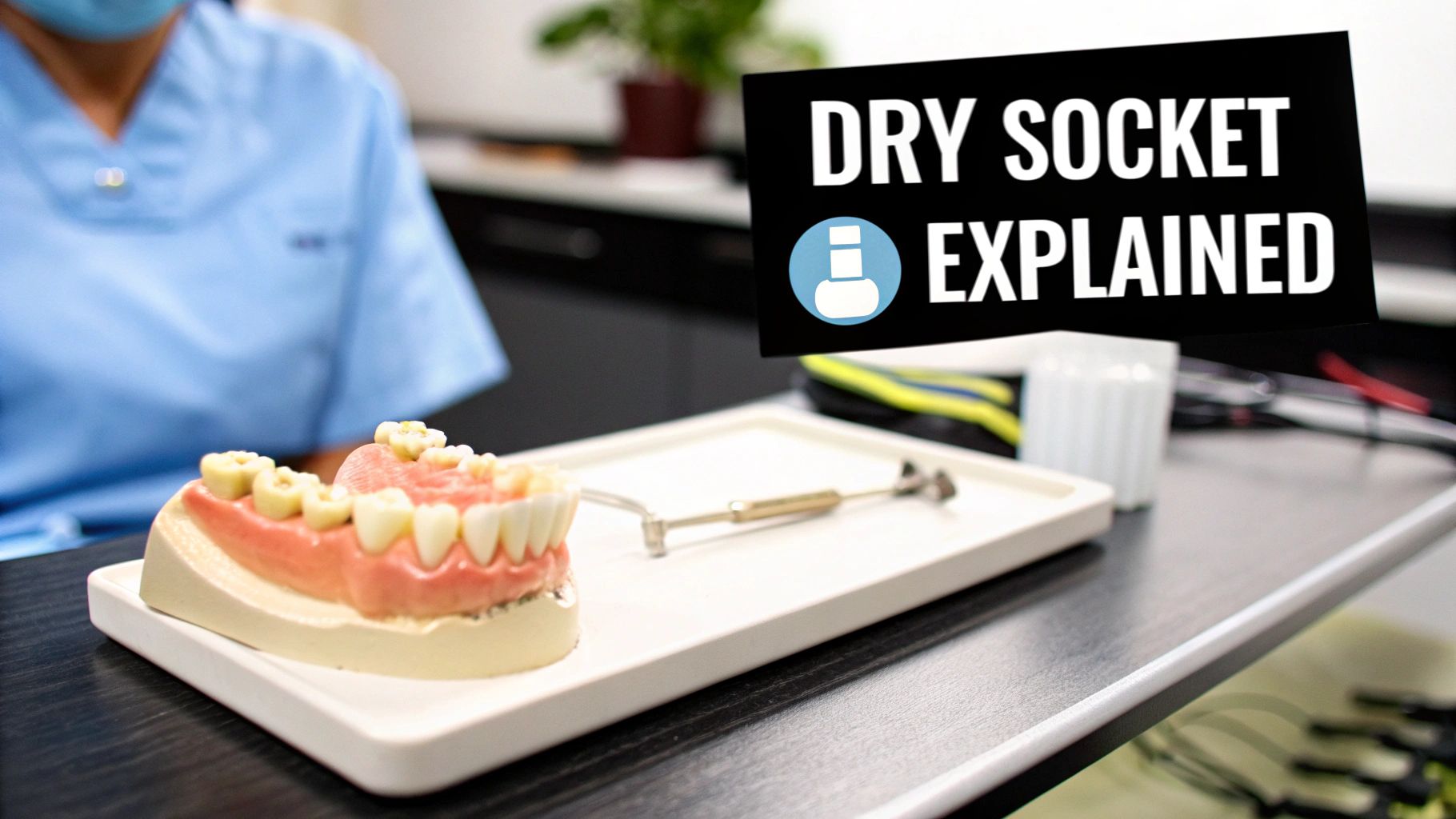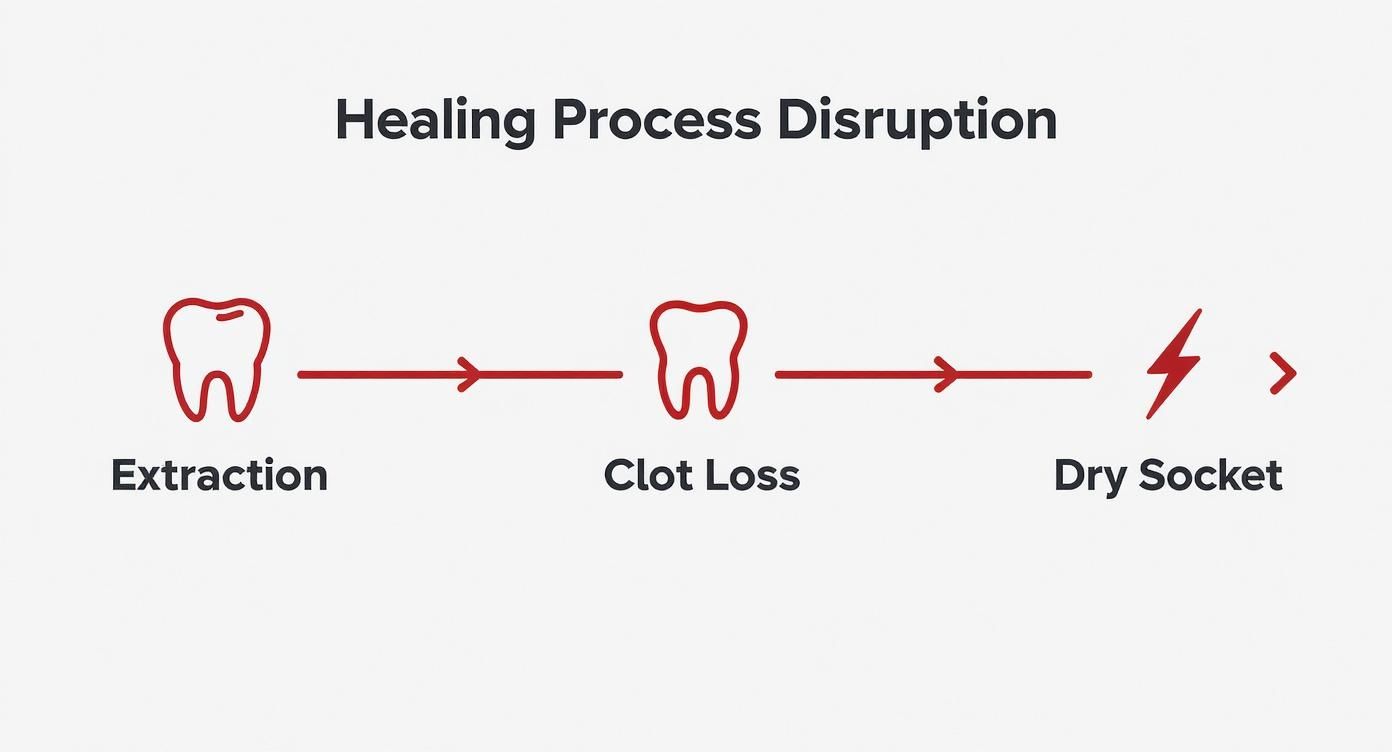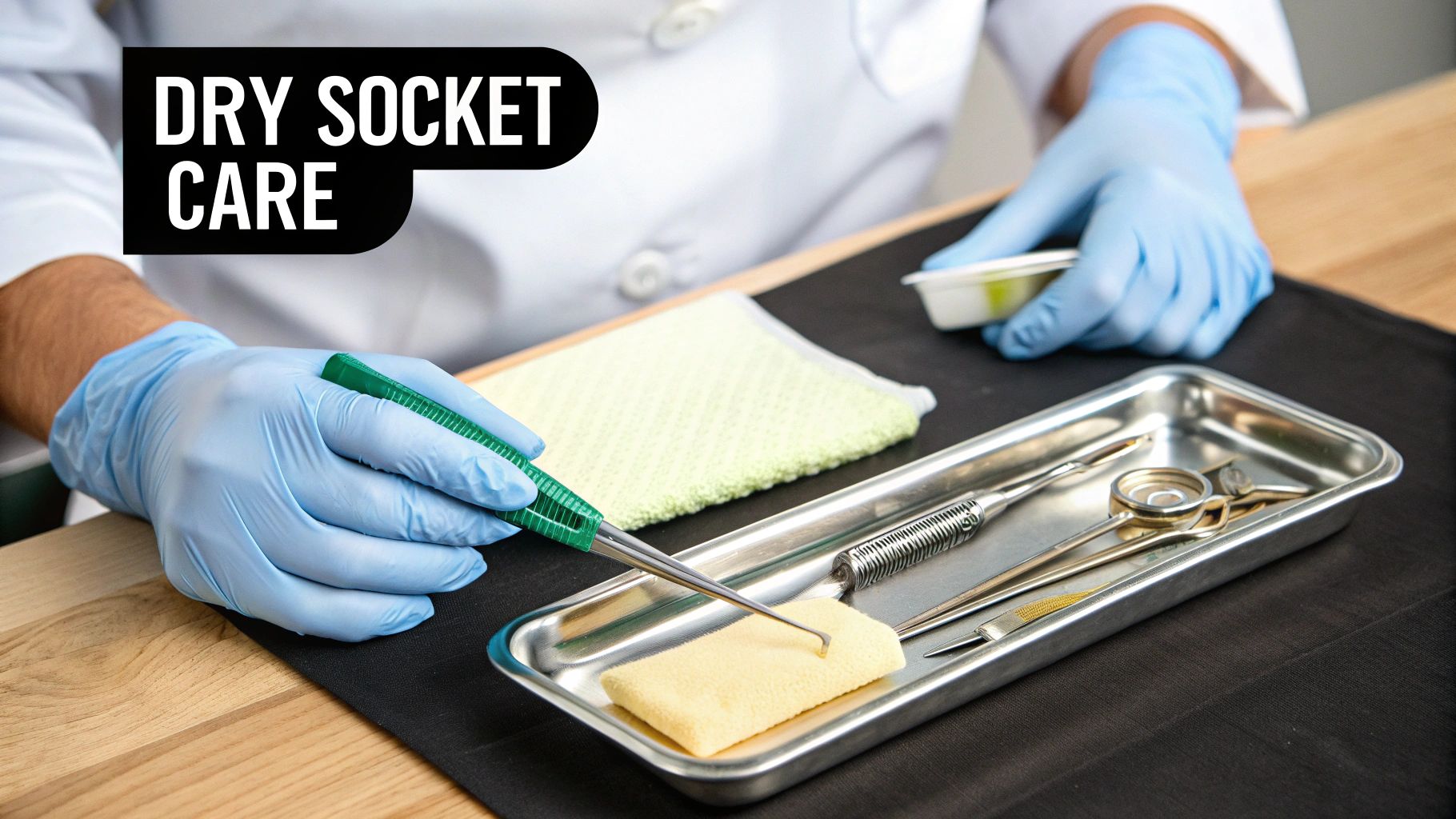Your Actionable Guide to Dry Socket After Wisdom Teeth Removal
- Caterina Rutter
- Nov 16
- 11 min read
Getting your wisdom teeth out is a common procedure, but recovery isn't always straightforward. A dry socket is the most frequent and painful complication you might face. It happens when the essential blood clot that forms in the extraction site is dislodged or dissolves before the wound has healed.
When that protective clot is gone, it leaves the underlying bone and nerve endings exposed to air, food, and fluids. This exposure not only triggers severe pain but also brings the healing process to a halt. You'll typically know if you have a dry socket within two to four days after your surgery. This guide provides the actionable insights you need to prevent it and know what to do if it happens.
What Is a Dry Socket and Why Should You Care?

Think of the blood clot as your body's own perfect bandage. After your wisdom tooth is removed, your body creates this clot to fill the empty socket. It’s not just a plug; it's the foundation for all the healing that follows.
This clot has two critical jobs. First, it acts as a shield, protecting the highly sensitive jawbone and nerves from anything in your mouth. Second, it provides the framework for new bone and gum tissue to grow. Without it, healing stops.
How a Dry Socket Derails Your Recovery
A dry socket, clinically known as alveolar osteitis, occurs when that natural bandage is lost too early. The entire healing process is disrupted.
Without the clot, the raw bone and nerves are left vulnerable, causing the signature throbbing pain of a dry socket. It’s a major setback because your body has to restart the healing process from scratch, but this time on a much more difficult foundation.
Actionable Insight: A dry socket isn't just a painful inconvenience; it's a complete breakdown of your body's healing plan. Losing the blood clot leaves the wound open and unprotected, guaranteeing significant pain and a much longer recovery.
To give you a practical way to assess your healing, here is a breakdown comparing a healthy socket to a dry socket.
Normal Healing vs. Dry Socket: A Practical Checklist
Healing Stage | What a Normal Socket Looks/Feels Like | What a Dry Socket Looks/Feels Like |
|---|---|---|
Initial Clot | A dark, stable blood clot fills the socket, acting as a protective plug. | The blood clot is gone, leaving a visibly empty or hollow-looking socket. |
Appearance | You can see the dark red clot. Gums look pink and are healing. | The socket may look whitish or yellowish from exposed bone instead of a dark clot. |
Pain Level | Pain should steadily decrease each day after surgery. | Pain suddenly gets worse 2-4 days after surgery, becoming a throbbing, radiating ache. |
Healing Progress | New pink tissue starts to form over the clot within a week. | Healing is stalled. The socket stays open and can trap food debris. |
This table provides a clear, actionable way to monitor your own healing process. If your experience aligns with the "Dry Socket" column, it's time to call your dentist.
What You Need to Know About a Dry Socket
Understanding the biology helps you understand your post-op instructions. Here's what's happening:
Exposed Nerves and Bone: This is the direct cause of the severe pain. Nerves in the jawbone are not meant to be exposed.
Delayed Healing: The clot is the scaffold for new tissue. Without it, the growth of new gums and bone is significantly delayed.
High Risk of Irritation: An open socket is a trap for food and bacteria, which causes inflammation, bad breath, and more pain.
Knowing what a dry socket is is the first step. For a deeper dive into the specific signs, our guide on what a dry socket feels like gives you more detail.
How to Recognize the Warning Signs of a Dry Socket

After wisdom teeth removal, some pain and swelling are normal. A dry socket is a different beast. The most actionable clue is a change in your pain pattern. Your discomfort should gradually improve each day. If your pain suddenly intensifies around day two to four, that is the single biggest red flag for a dry socket.
This isn't just a dull ache. It's a severe, throbbing pain that over-the-counter medication likely won't relieve. This dramatic shift from "I'm healing" to "This is much worse" is your body's signal to seek help.
Identify the Type of Pain You're Feeling
A key sign of a dry socket after wisdom teeth removal is that the pain radiates. Normal post-op pain is localized to the extraction site. Dry socket pain travels.
The intense ache often starts at the empty socket and moves along your jawline. You may feel it spreading up toward your ear, temple, or eye on the same side of your face. This happens because the exposed nerve endings are sending powerful pain signals along the major nerve pathways in your head.
While you wait to see your dentist, finding effective strategies for severe tooth pain relief can help manage the discomfort.
Actionable Clues You Can See and Smell
Pain is the primary symptom, but you can also look for visual signs. With clean hands, gently pull back your cheek and look at the extraction site in a mirror. A healthy socket will have a dark, reddish-brown blood clot inside. A dry socket will look noticeably empty.
Actionable Insight: The most definitive visual sign of a dry socket is seeing the whitish or yellowish jawbone at the bottom of the socket instead of a dark clot. The area will look hollow.
Your senses of taste and smell can also provide clues. A persistent bad taste in your mouth that rinsing doesn't fix is a common complaint. This is often accompanied by a foul odor or bad breath, caused by bacteria and food debris collecting in the unprotected socket.
Here’s your quick action checklist for identifying a dry socket:
Worsening Pain: A severe, throbbing pain that starts 2-4 days after surgery and doesn't improve with your prescribed painkillers.
Radiating Pain: Discomfort that spreads from the socket to your ear, eye, temple, or neck.
Visible Empty Socket: Looking in the mirror and seeing a hollow space or visible bone where the blood clot should be.
Bad Taste or Smell: A persistent foul taste or bad breath originating from the surgical site.
If these symptoms match your experience, don't wait. Call your dentist or oral surgeon immediately. For more detailed visuals and descriptions, check our guide on what are the signs of a dry socket.
What Actions Increase Your Risk of Dry Socket?
Your best defense against a dry socket is knowing what causes it. It’s not just bad luck; specific actions and conditions can disrupt your body's healing process.
The primary cause is the loss of the protective blood clot. Sometimes this is due to a difficult surgery, especially with an impacted wisdom tooth, which can cause more trauma and make it harder for a stable clot to form.
However, your actions after leaving the dental chair are often the deciding factor. Understanding these triggers gives you the power to ensure a smoother recovery.
How Your Habits Directly Impact Healing
Your daily habits in the days following surgery can make or break the healing process. Simple actions can jeopardize the fragile blood clot.
Smoking is the number one risk factor. Nicotine constricts blood vessels, reducing the supply of oxygen and nutrients to the healing socket. More importantly, the physical act of inhaling creates suction in your mouth that can easily pull the clot out.
Actionable Insight: The data is clear. Smokers have a 12% chance of developing a dry socket, compared to just 4% for non-smokers. This means smoking triples your risk. Avoid all smoking and vaping for as long as possible after surgery.
This is why your oral surgeon will stress the importance of avoiding all tobacco and nicotine products after your procedure.
Other Key Risk Factors You Can Control
Beyond smoking, a few other factors increase your risk. Being aware of them allows you to take preventative steps.
Oral Contraceptives: Estrogen in birth control pills can interfere with blood clotting. If possible, schedule your extraction during a week when your estrogen levels are lower (typically days 23-28 of your cycle).
Poor Oral Hygiene: Failing to keep your mouth clean (gently!) allows bacteria to thrive, which can lead to an infection that breaks down the blood clot.
Creating Suction: This is a critical point. Any action that creates negative pressure in your mouth is a direct threat. This includes drinking through a straw, spitting forcefully, or aggressive rinsing. These all act like a vacuum and can dislodge the clot.
Research confirms that the type of surgery matters. The risk of dry socket after a simple tooth extraction is low—about 1.7%. For complex surgical extractions, like impacted wisdom teeth, that risk can jump to 15%. You can explore the data in this study on dry socket risk factors.
By actively managing these factors, you become a partner in your own successful recovery.
Your Action Plan for Preventing Dry Socket
Preventing dry socket boils down to one critical mission: protect the blood clot. Your actions in the first few days after wisdom teeth removal will determine your recovery's success. This straightforward plan will help you navigate the healing process and minimize your risk.
Losing the clot is the single event that exposes bone and nerves, leading directly to the intense pain of a dry socket.

As you can see, every preventative measure is designed to keep that clot in place.
The First 24-48 Hours: Your Clot Protection Plan
This is the most critical period. The blood clot is extremely fragile, and your primary goal is to be gentle and avoid any pressure changes in your mouth.
Your immediate action checklist:
Bite Firmly on Gauze: For the first hour, maintain gentle, steady pressure on the gauze placed by your surgeon. This helps a solid clot form.
Rest and Elevate Your Head: Take it easy. Keep your head propped up with pillows, even while sleeping. This helps reduce bleeding and swelling.
Stick to Cold, Soft Foods: Eat things like yogurt, applesauce, or smoothies (with a spoon, not a straw). Hot liquids can dissolve the clot, so avoid soup or coffee for the first day.
The Following Week: A Guide to Gentle Healing
After the first 48 hours, the clot is more stable but still vulnerable. Your focus should shift to keeping your mouth clean without disturbing the healing site.
Follow these steps for at least one week:
Transition to Soft, Warm Foods: You can now eat things like scrambled eggs, mashed potatoes, or pasta. Continue to avoid anything hard, crunchy, sticky, or with small seeds that could get stuck.
Rinse Gently: After 24 hours, you can begin rinsing with a warm salt water solution (½ teaspoon of salt in 8 ounces of water) after meals. Do not spit. Tilt your head to let the water fall out into the sink.
Brush with Caution: You must brush your other teeth, but be extremely careful near the extraction site. Do not let your toothbrush touch the healing socket.
Crucial Warning: Any action creating suction is the clot's worst enemy. Smoking, vaping, using a straw, and forceful spitting create a vacuum that can pull the clot out. This is a direct and preventable cause of dry socket after wisdom teeth removal.
Thinking about long-term oral health is also beneficial. Learn about critical oral health tests and strategies to prevent bacterial infections to promote a healthier mouth and better healing overall.
By following this action plan, you take control of your recovery and significantly reduce your risk of complications.
How Dentists Provide Fast Relief for Dry Socket

If you have a dry socket, know that the treatment is straightforward and designed to provide immediate relief from the severe pain. Your dentist's goal is to clean the area, protect it, and get your healing back on track.
First, your dentist will gently clean the socket. Any food particles or debris that have become trapped will be carefully flushed out with a sterile solution. This step is critical to remove irritants and reduce the risk of infection, allowing healing to begin properly.
How a Medicated Dressing Works
Once the socket is clean, the key treatment begins: your dentist will place a special medicated dressing into the socket. This is not just gauze; it's a packing material often infused with soothing agents like eugenol (clove oil).
This dressing serves as a substitute for the lost blood clot. It creates a physical barrier, shielding the exposed bone and nerve endings from air and food. This is what provides the profound, near-instant pain relief that makes treatment for a dry socket after wisdom teeth removal so effective.
Actionable Insight: The medicated dressing provides fast relief by doing two things at once: it physically protects the exposed nerves from painful stimuli while delivering soothing medication directly to the source of the pain.
You may need to return every day or two for a fresh dressing initially, depending on your pain level. As healing progresses and pain subsides, these visits will become less frequent.
Your At-Home Pain Management Plan
Your dentist will also give you an actionable plan for managing discomfort at home. This typically includes specific instructions for over-the-counter pain relievers, which become much more effective once the medicated dressing is in place. You will also be taught how to gently rinse at home to keep the area clean without disturbing the dressing. For more detailed steps, check out our guide on what to do if you have a dry socket.
Understanding the clinical side can also be reassuring. One study on lower wisdom tooth removal found the overall dry socket rate to be 9.6%. Interestingly, the use of certain materials during surgery, like Surgicel gauze, was associated with a much higher rate (25.0%) compared to sockets without it (6.0%). This kind of data helps dentists continually improve surgical techniques to minimize risks for patients.
Your Top Questions About Dry Socket Answered
Even with a clear plan, questions and concerns are normal after wisdom teeth removal. Getting direct, practical answers can provide peace of mind and help you feel in control of your healing. Here are the most common questions we hear about dry socket after wisdom teeth removal.
How Long Does Dry Socket Pain Last After Treatment?
This is the most urgent question for anyone in pain. The answer is encouraging: once your dentist cleans the socket and places a medicated dressing, you should experience significant pain relief within 24 to 48 hours.
The severe, throbbing pain subsides quickly because the dressing protects the exposed nerve and bone. If you attempt to wait it out without treatment, the pain can last for a miserable 7 to 10 days. The most actionable step you can take is to see your dentist as soon as you suspect a problem.
Can I Still Get Dry Socket a Week After Surgery?
This is highly unlikely. Dry socket is an early complication, almost always appearing between day two and day four post-extraction. This is the window when the initial blood clot is most fragile.
By one week, your body has already started replacing the clot with granulation tissue—the foundation for new gum and bone. If you experience a sudden onset of new, severe pain a week or more after surgery, it is more likely a sign of a different issue, such as an infection. You should call your dentist immediately to have it evaluated.
Actionable Insight: The high-risk window for dry socket is short. If brand-new, severe pain appears a week later, it’s a signal that something else needs a professional look.
What Does a Dry Socket Actually Look Like?
While severe pain is the main symptom, a visual check can also provide clues. A healthy, healing socket should contain a dark, scab-like blood clot. Over a few days, you'll see new pinkish-white tissue forming around the edges.
A dry socket, in contrast, looks unnervingly empty. Instead of a dark clot, you might see the whitish or yellowish jawbone at the bottom of the socket. The surrounding gums may also appear inflamed and redder than the rest of your mouth.
Here’s a simple visual comparison:
Healthy Socket: Looks filled with a dark, jelly-like substance (the blood clot).
Dry Socket: Appears hollow; you might see the whitish bone at the base.
However, do not rely solely on a visual check. It can be hard to see the area clearly, and the most reliable indicator is always the onset of severe, radiating pain that worsens a few days after your procedure. If you suspect a problem, the best action is always to get a professional evaluation.
At Beautiful Dentistry, we understand that recovering from wisdom teeth removal can be stressful. Our team is committed to making your recovery as smooth and pain-free as possible. If you have concerns about your healing or need expert dental care in Tempe, Arizona, we are here to help. Schedule your appointment today by visiting us at https://zdentist.com.


Comments